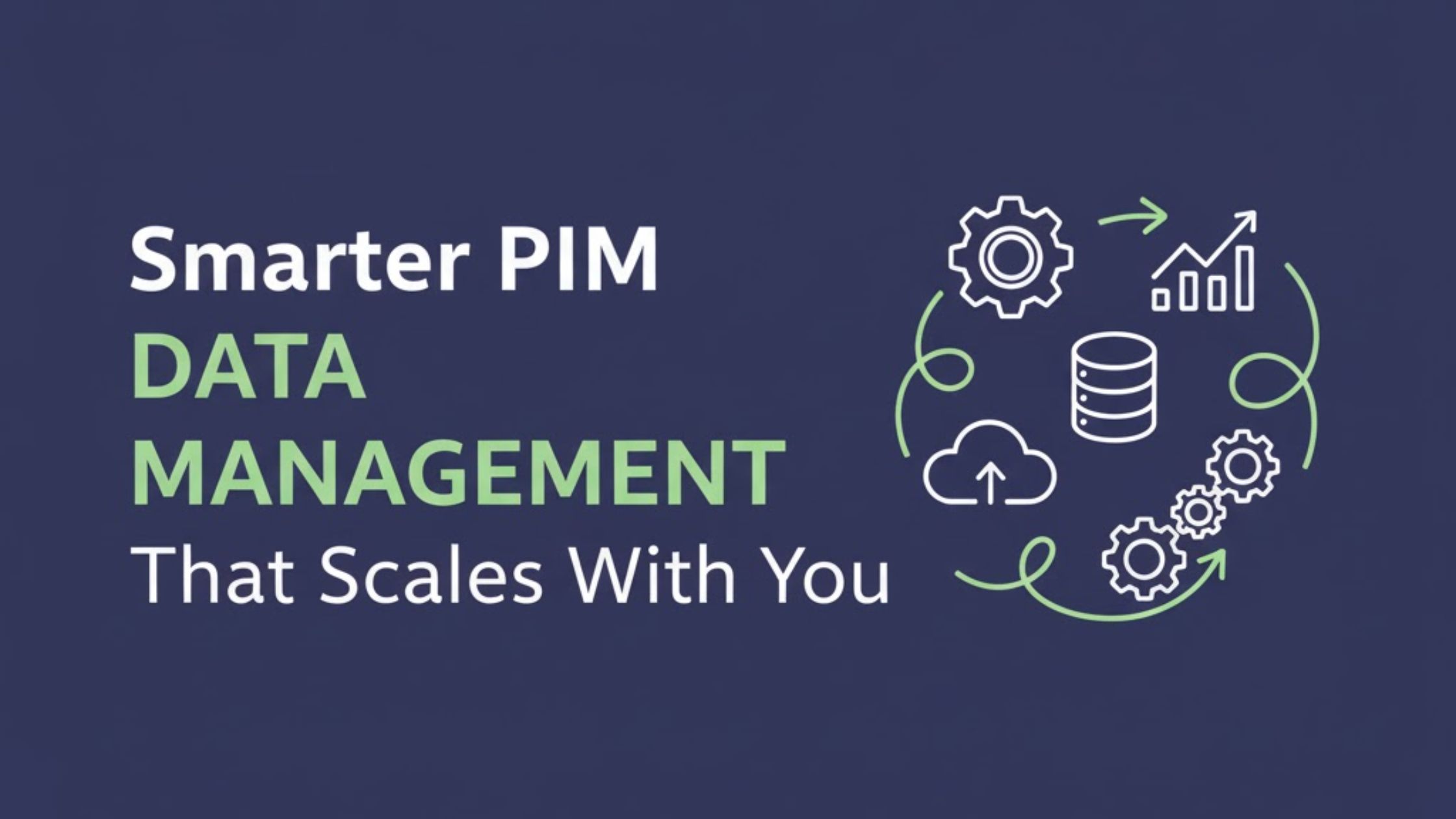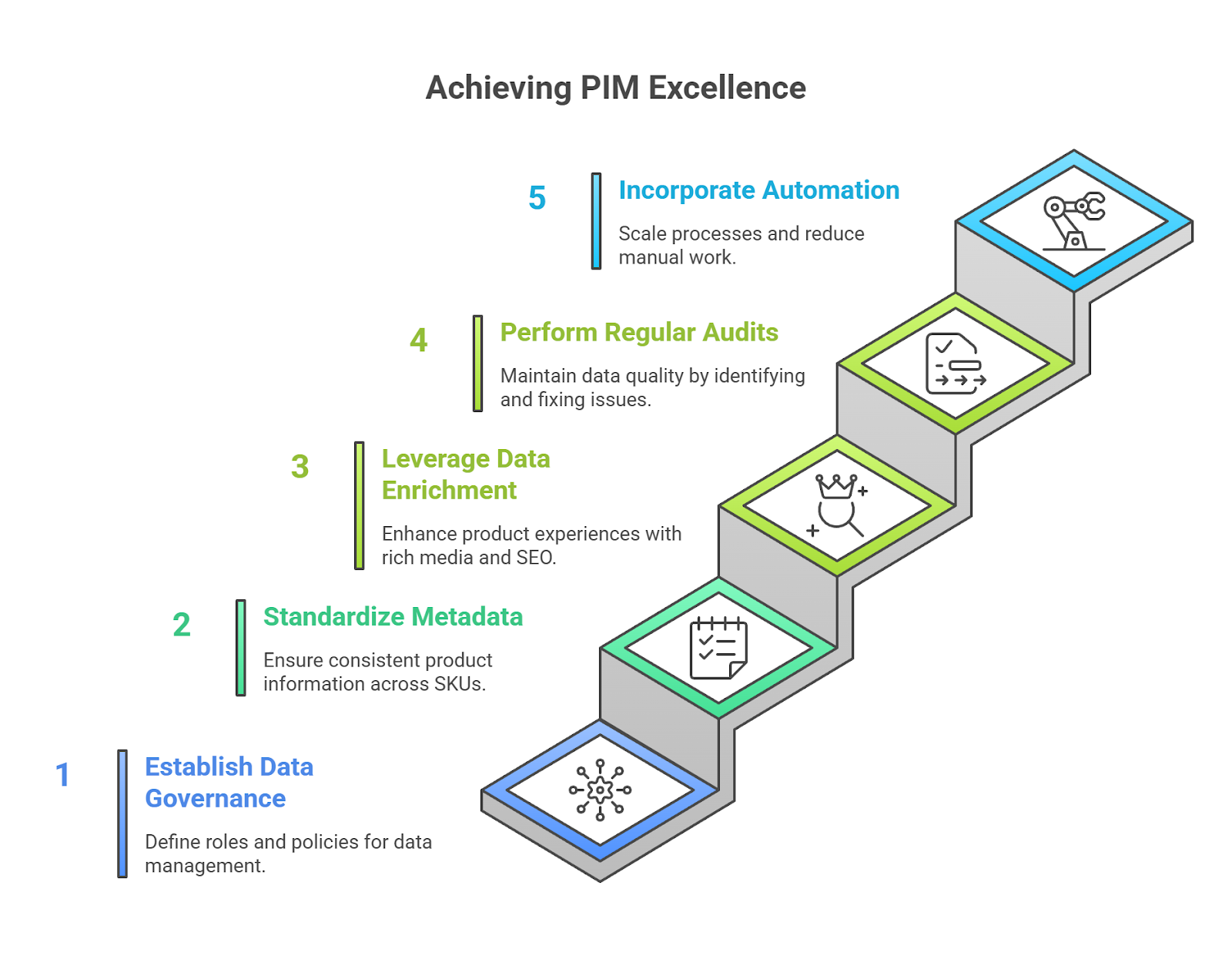Smarter PIM Data Management That Scales With You

Smarter PIM Data Management That Scales With You
Effective PIM data management is no longer optional and not foundational for businesses vying to excel in today’s digital commerce landscape.
With product assortments growing increasingly complex and sales channels multiplying rapidly, companies face the twin challenges of managing high‐volume product data and distributing it across diverse touchpoints.
A modern, cloud‑native PIM platform offers a way to centralize, enrich, and distribute product data at scale, ensuring that your product information remains accurate, consistent, and ready for every channel.
Understanding PIM Data Management

“Product information management” (PIM) refers to the process and technology by which organizations collect, manage, enrich and centralize their product information so they can distribute it efficiently to all sales, marketing and commerce channels.
While often conflated with master data management (MDM) or enterprise resource planning (ERP) systems, PIM is distinct in focusing solely on product data.
The goal of PIM data management is to give businesses a single source of truth for product information, enabling faster time‑to‑market, higher data quality and seamless multi‑channel experiences.
Key Benefits of Implementing PIM Solutions
Adopting a robust PIM solution unlocks a wide range of benefits:
- Streamlined product catalog management across numerous channels. Because all product information is managed centrally, you avoid silos and duplicate data.
- Improved product data quality and accuracy. With consistent governance and enrichment workflows, your product information becomes trustworthy and up‑to‑date.
- Enhanced data enrichment using automation tools. Digital assets, localized content, metadata and channel‑specific formats can be managed and distributed more efficiently.
- Stronger compliance and governance over product information. When you operate across multiple regions or channels, governance becomes critical, and PIM supports that.
- Faster roll‑out to new channels and markets. The centralized repository and automated workflows reduce launch time and operational overhead.
Each of these benefits contributes to operational efficiency, improved conversion rates, and reduced risk, which are key business drivers for PIM implementation.
Core Features of Modern PIM Platforms
In order to deliver the benefits above, modern PIM platforms include several core features:
Centralized Product Database
A PIM solution houses all product information—technical specs, attributes, SKUs, digital assets—within a unified repository.
Digital Asset Management and Rich Media Integration
Effective product information management goes beyond text. Rich media (images, videos, documents) and digital asset management (DAM) integration are essential to presenting compelling product stories across channels.
Integration with Ecommerce, ERP and Marketplaces
A key strength of a modern PIM is its ability to integrate via API with e‑commerce platforms, ERP systems, marketplaces and other downstream channels, ensuring seamless data flow.
Automation and Enrichment Capabilities
Automation and enrichment tools allow teams to manage structured product data, metadata, workflows and data quality checks. This supports structured data, digital asset enrichment, localization and more.
Structured Product Data and Product Content Management
PIM supports the creation and management of structured product data and optimizes it for each channel and audience.
How PIM Drives Multi‑Channel Product Data Management
In today’s omnichannel world, product data must travel flawlessly across websites, marketplaces, mobile apps, print catalogues and more.
A PIM platform enables this by maintaining consistent, channel‑ready product information:
- You maintain synchronized, accurate product data across all digital touchpoints.
- Localization and regional content become manageable: language variations, currency, regulatory attributes are handled centrally.
- Channel-specific formats (for Amazon, Google, marketplaces) are generated from the same central dataset, reducing time‑to‑market and risk of error.
- Higher data quality translates into better customer experience. It’s all about less product returns, fewer support calls, higher conversion.
Best Practices for Effective PIM Data Management
To get the most out of your PIM solution, certain best practices should be followed:
- First, establish clear data governance policies. Know who owns product attributes, workflows for approval, versioning, auditing.
- Second, standardize product metadata and content formats. Define attribute types, taxonomy, localization requirements, and ensure consistent structure across SKUs.
- Third, leverage data enrichment tools. Use rich media, descriptive content, SEO‑optimized descriptions, channel‑specific formats to enhance product experiences.
- Fourth, perform regular audits of your product data to maintain product data quality. Identify missing attributes, duplicates, inconsistencies, and fix them promptly.
- Fifth, incorporate automation and workflow tools into your PIM ecosystem to scale processes and reduce manual work as volume grows.

Choosing the Right PIM Software
Selecting the right PIM software is critical. When evaluating solutions, look for:
- Feature set: centralized database, integration capabilities (ERP, e‑commerce, marketplace), enrichment tools, DAM support.
- Scalability and flexibility: cloud‑native, API‑first architecture ensures you can scale as your product data grows and new channels emerge.
- Vendor support, training and success stories: credible implementation and domain expertise matter.
- Fit with your organization’s needs: number of SKUs, number of channels, localization complexity, enterprise vs. mid‑market.
- Ecosystem compatibility: ability to integrate with existing systems and support data distribution across your specific channel mix.
Measuring the ROI of PIM Solutions
Once implemented, how do you measure the return on your PIM investment?
You’ll see increased efficiency in product data workflows. There will be less manual entries, fewer errors, and faster publishing.
Conversion rates improve thanks to richer, consistent product content across channels.
Time‑to‑market shortens and new products and SKUs can launch faster.
Costs associated with returned items and support are reduced because customers receive accurate product information.
These outcomes align with business priorities and justify the investment in modern PIM data management.
Empower Your Business With Centralized, Future-Ready Product Data
Modern businesses cannot afford to let product data become a disconnected, error‑prone web of spreadsheets and legacy systems.
Investing in smarter PIM data management equips organizations with the foundation to scale, enrich and distribute product information across every channel, and ensures you are ready for future growth. With the right PIM platform, your product data becomes a strategic asset.
Are you ready to explore how a cloud‑native, API‑first PIM can accelerate your product content management and drive results?
Discover how our solution at Ergonode can centralize your data, enrich your catalog and scale with you.






